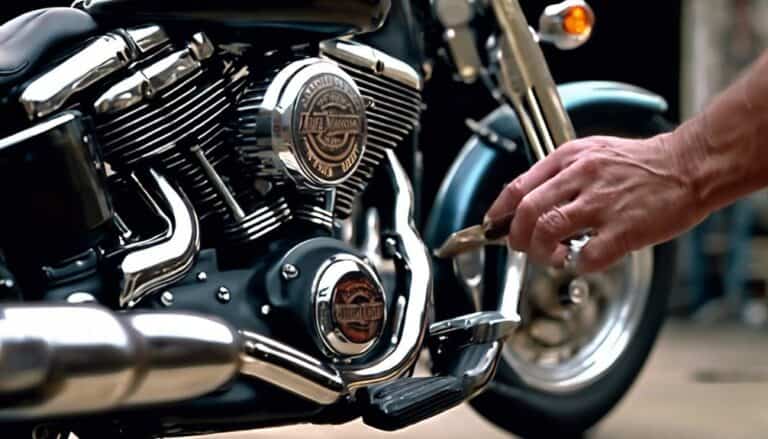When assessing a used 1996 Harley Davidson, you may not realize that certain model variations from that year have specific quirks or mechanical issues that could impact your buying decision. Understanding these nuances can save you time and money in the long run.
By paying attention to details like frame condition, maintenance records, and aftermarket modifications, you can gain insight into the bike's overall health and potential future expenses.
Stay tuned to discover how a thorough evaluation can provide you with peace of mind and confidence in your purchase.
Key Takeaways
- Review maintenance history for insights into care and recurring issues.
- Inspect exterior for rust, dents, and damages affecting safety and aesthetics.
- Verify engine details and tire condition for maintenance and repair considerations.
- Analyze mileage, service history, and upgrades for past care and pricing insights.
Key Factors to Consider
When evaluating a used 1996 Harley Davidson, the key factors to consider encompass the bike's documented maintenance and service history for crucial insights into its care and upkeep. By reviewing the maintenance records, you can gauge how well the motorcycle has been cared for over the years. Look for regular servicing, oil changes, and any major repairs that have been conducted. These records can provide a clear picture of the bike's condition and the level of attention it has received.
Additionally, examining the values shown in the maintenance history can give you an idea of any recurring issues or patterns that may affect the bike's performance. For example, frequent repairs to the engine or transmission could indicate underlying problems that need to be addressed. Understanding the maintenance history is essential in determining the overall health of the motorcycle and whether it aligns with your expectations and standards.
Exterior Inspection
Inspecting the exterior of a used 1996 Harley Davidson involves scrutinizing for signs of wear, damage, and modifications that can impact both aesthetics and value. When evaluating a Road King of this vintage, it's crucial to pay attention to the overall condition to ensure you're making a wise investment. Here's a breakdown of what to look for:
| Aspects to Inspect | What to Look For | Impact on Value |
|---|---|---|
| Rust or Corrosion | Check for any signs of rust or corrosion on the body panels. | Can decrease the value significantly. |
| Dents, Scratches, Dings | Inspect for any dents, scratches, or dings that affect the appearance. | May lower the resale value. |
| Chrome/Metal Finishes | Look out for pitting, flaking, or discoloration on chrome or metal parts. | Poor condition can diminish the bike's appeal. |
| Windshield, Mirrors, Lights | Evaluate for cracks, chips, or missing parts on these components. | Damages can impact safety and overall aesthetics. |
Engine and Mechanical Assessment
Evaluate the engine and mechanical components of the used 1996 Harley Davidson to ensure a comprehensive understanding of the bike's overall condition and maintenance history. Begin by verifying any detailed engine work that has been done, especially focusing on modifications or replacements. Check for any replaced components such as engine cases or major parts, as this can indicate the level of maintenance the bike has undergone. It's crucial to ensure proper fuel management, particularly if there have been modifications, to prevent any potential performance issues. Additionally, consider the fuel economy of this model year to gauge its efficiency and running costs.
When assessing the mechanical aspects, pay close attention to the tire condition and brand. This evaluation can provide insights into the bike's maintenance history and potential future costs. Finally, factor in any necessary repairs or upgrades when determining a fair price based on the bike's current mechanical state. This comprehensive examination will give you a clearer picture of the Harley Davidson's overall health and value.
Mileage and Service History
To gain valuable insights into the 1996 Harley-Davidson's past care and potential durability, closely examine its mileage and detailed service history. When assessing the mileage, lower numbers typically imply less wear and tear, suggesting better overall condition. Scrutinize the service history records to confirm regular maintenance, which significantly influences the bike's health. Look for recent major services like engine rebuilds or part replacements to gauge reliability accurately. Also, consider the riding style; aggressive or long-distance use can impact the bike's mechanical state. Verify if any modifications or aftermarket upgrades have been installed and assess their effects on performance and value.
| Mileage | Service History |
|---|---|
| Low mileage is preferable. | Check for regular maintenance. |
| Indicates less wear and tear. | Look for recent major services. |
| Consider the type of riding. | Verify modifications or upgrades. |
Pricing and Negotiation Tips
When considering the purchase of a used 1996 Harley-Davidson, understanding pricing strategies and negotiation techniques is crucial for securing a fair deal. Researching market prices for 1996 Harley-Davidson motorcycles will give you a baseline to determine if the asking price is reasonable.
Keep in mind that additional budget may be required for maintenance and repairs, so factor this into your negotiations. Be cautious when buying from a friend, as they mightn't disclose all issues the bike has. Before discussing pricing, take the motorcycle for an extensive test ride to ensure it meets your expectations.
When negotiating, consider potential costs for fixing known issues or making desired upgrades as part of your offer. By being informed about the market value and willing to walk away if the deal isn't right, you can increase your chances of getting a fair price on a 1996 Harley-Davidson.
Conclusion
In conclusion, when evaluating a used 1996 Harley Davidson, be sure to thoroughly inspect all aspects of the bike, from the exterior to the engine and service history.
Remember, 'the devil is in the details,' so don't overlook any potential red flags or signs of wear and tear.
By conducting a comprehensive assessment and researching market prices, you can make an informed decision and ensure a fair deal on your purchase.

